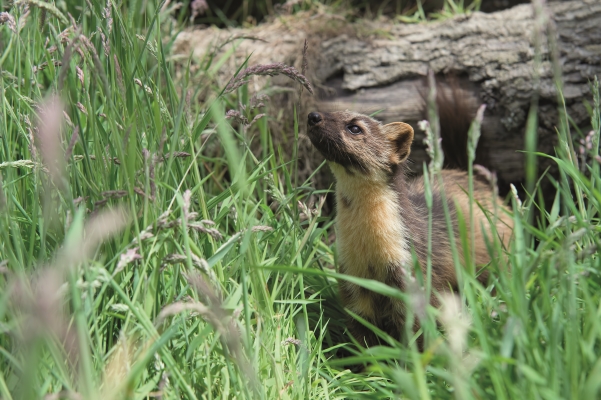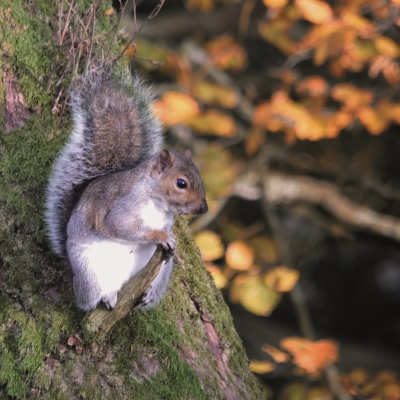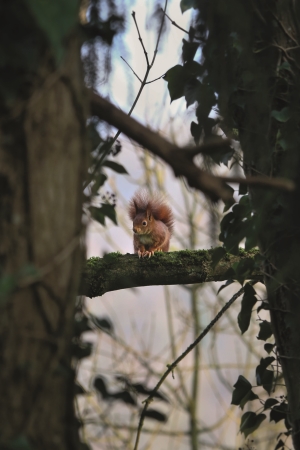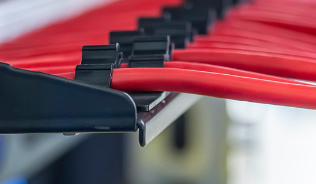environmental SCIENTIST | Unintended consequences in environmental science | August 2018
Paddy Fowler speaks to Emma Sheehy about the unintended consequences of a resurgence in pine marten numbers in Ireland and Scotland. Emma Sheehy is an ecologist currently investigating the role of the European pine marten on red and grey squirrel population dynamics in Scotland and Ireland. We spoke to Emma about her past and current research on the relationship and the history of pine martens and squirrels in Ireland and the UK, and how the results of her work could have impacts on future reintroductions and species recovery.
Could you give us a little background on both pine marten and squirrel populations in Ireland and the UK?
Historically pine martens were widespread in Ireland and the UK, but as a result of large-scale deforestation, by the turn of this century they had been reduced to a couple of relic populations in the north and north-west of Scotland and in the west and midlands of Ireland. They were functionally extinct in England and Wales and really rare if present at all in the rest of Ireland. Change only became apparent as they became protected by law in the 1970s in Ireland and 1980s in the UK, and as forest cover increased over the last century.
Red squirrels were also widespread throughout the UK and Ireland, and they suffered similarly from the widespread deforestation. It was also legal to hunt red squirrels as they were considered a pest because of their bark stripping. Another threat came from grey squirrels, first introduced into the UK roughly 150 years ago and into Ireland in 1911. For quite a long time it was anecdotal reports rather than scientific studies that indicated that grey squirrels had a detrimental impact on red squirrels. We now know that grey squirrels compete with reds both for space and food, and they also carry the squirrel pox virus. It is incredibly rare for the virus to be symptomatic in greys, but it is deadly for red squirrels as they have not evolved any immunity and therefore, once the virus enters a population it can have dramatic effects, especially as it is density dependent.

So what is happening now?
In around 2008, we received the first anecdotal reports of red squirrels returning to land previously inhabited by grey squirrels, areas they hadn’t been seen in for many decades. At the same time, pine martens were also being noticed in the same areas. These reports were coming from foresters and gamekeepers, people who were spending a lot of time in the woodland and could see the changes day to day. Reports were emerging both in Ireland and Scotland.
In 2009, I was completing my undergraduate Zoology degree at NUI Galway. It was here that the anecdotal reports were coming in as part of the Irish Squirrel Survey, more and more frequently from unconnected sources. To take the next step, we applied for me to do a PhD to see if pine martens were playing a role in squirrel distribution. Quite honestly, we did not expect to find that the pine martens would be having a positive effect on red squirrels. Up until this point, anyone who had done any research on the relationships between red and grey squirrels could only find negative impacts of greys on reds. We were going very much against the literature and wisdom to suggest that red squirrels would be doing better than greys under any circumstance.
I was focusing my research in the east and midlands of Ireland and working on two projects in parallel. The first of these was a large-scale citizen science survey where people were invited to submit sightings; this was highly successful and I received well over a thousand valid entries. We could see that in terms of distribution, the density of sightings of pine martens and red squirrels overlapped more or less completely, whereas there was a negative correlation between pine martens and grey squirrels. Grey squirrels had all but disappeared from parts of the country where there were records of them being very well established.
The second element of the project involved live trapping in a perfect habitat in the midlands that had a very well-established grey squirrel population and where red squirrels had been absent for more than 30 years. We had heard from the landowner that they had spotted pine martens and red squirrels returning and fewer grey squirrels about. Lo and behold, we were trapping five pine martens repeatedly in around 100 hectares of woodland, a large number for the area, with a really healthy population of red squirrels throughout. The site’s population of grey squirrels was found to have shrunk considerably, and after a series of week-long tracking sessions over a period of two years, only three adults and three juveniles were recorded throughout the entirety of the study. We were also trapping in the east of Ireland, in an area that had recently seen one adult pine marten return to a specific section of woodland. The grey squirrel population was still very healthy and that single pine marten had yet to make a large impact on the population, but this may be explained by the fact that the trapping period here was significantly shorter and therefore the impact a single animal may have made could not have been picked up.
Comparing these two datasets indicated correlation, but causation could not be justified at this stage. The same can be said about the anecdotal sightings and reports: although there was a strong correlation between pine marten and red squirrel populations there was not enough data to imply causation. Although this was evidence enough to convince a great number of people that the pine martens were the driving force, for me, as a scientist, this was something I felt I needed to study further.

You had to go back and find out more – you were left with unanswered questions.
That’s how science works: you form a hypothesis, you test it and you form more detailed hypotheses. I finished my PhD in 2013 and in the resulting paper, published in 2014, we basically said that there was a population crash in grey squirrels. It was regional and specific, and it correlated with pine marten distribution, but we didn’t know for sure if it was directly related.
For my post-doctoral studies, I wanted to see if the same thing was happening in Scotland. Also, I wanted to investigate causation, either on a landscape level, i.e. are pine martens suppressing the grey squirrel population? Or by looking at the mechanism of the interaction between pine martens and grey squirrels at the woodland level. These were two different questions on two different scales, and looking at the woodland level in Scotland would have been putting the cart before the horse, so we had to look at causation in populations first.
Because with any PhD or post-doctoral study you have funding for a specific time frame, you have to ensure that you get both high-quality data and a lot of data within that timeframe. You have to think about how your study can represent a long timeframe when you only have a few years to carry out your work. So I substituted space for time: I sampled areas where pine martens were fully established and had been for some time, areas where pine martens had taken up residency more recently, and areas where they were only just appearing. This offered three timepoints laterally so a timeline could be established for long, medium and short residency. In order to gather a large amount of data, we used non-invasive techniques: detection/non-detection data from squirrels, and DNA from pine marten hair samples to identify individual martens, from 223 multi-species feeders and 19 trail cameras. It worked really well, and we were able to look in the three regions at the scale of the squirrels’ home range and the intensity of the space used by pine martens, allowing us to see if that was having any effect on red or grey squirrels.
I should probably talk a little about the models as some of the key findings are a result of how the models work. We used occupancy models for squirrels; for pine martens, we used spatial capture-recapture techniques with DNA sampling. We didn’t actually capture any animals but getting the DNA of one animal from the hair samples was marked as a capture. Using the spatial capture-recapture models we were able to look at how the intensity of space used by pine martens was affecting squirrel occupancy with regards to their home range. To look at occupancy you have to calculate two things: the probability of detecting a species given that they are there and the probability of occupancy.
What we found was that pine martens had a strong effect on the probability of detection, differing between the two squirrel species. For red squirrels, given that they were present, they were far less likely to be detected as pine marten activity increased. Their presence was not being affected by pine martens but their behaviour was: they were more cautious and harder to detect when pine martens were present. Conversely, grey squirrels showed no caution at all and in fact, the probability of detection rose. This indicated that they were naïve to the threat of a tree-climbing predator, whereas red squirrels weren’t. This makes sense when you think of red squirrels and pine martens overlapping throughout their home ranges for millennia, in contrast to grey squirrels, which are from the east coast of North America where they don’t overlap with American martens, fishers (which are related to American martens) or any other tree-climbing predator.
The probability of occupancy for red squirrels was higher with an increase in pine marten activity. In fact, red squirrel occupancy was highest in the areas where pine martens had been established longest. Grey squirrel probability of occupancy was really strongly negatively affected by exposure to pine martens. There were only two regions to compare (where pine martens had recolonised 5–15 years ago versus 0–5 years ago) but there was a very similar relationship. Where pine martens had been established for longer, the baseline for grey squirrel occupancy in the region was quite a bit lower, and in the region where pine martens had been present for a shorter amount of time, we could see the same relationship more dramatically, as we started with no pine martens and a large number of grey squirrels – the population of greys dropped dramatically as pine marten activity increased. As far as we are concerned you can’t really get any more conclusive: the more pine marten activity the less likely greys occupy an area.
So what is actually happening between the species?
I personally do not know if pine martens are eating grey squirrels or if they are pushing them out of the habitats. However, I would be very surprised if direct predation wasn’t the main cause. You would think that it would be, as we have seen from our detection models that greys aren’t cautious, making them more susceptible, but we don’t actually know for sure, so that is the next step.
There are a couple of PhDs going on at the moment, one in Exeter and one in Queen’s University Belfast, that are looking at that element, so with a bit of luck they will be able to shed some light on it. I have a feeling it is going to have to be a longitudinal study and will have to focus on populations where for a reasonable period of time there is an overlap of pine martens and grey squirrels. The ideal would be to work out an area that has a healthy grey squirrel population and is just about to see pine martens return so that you could collect data throughout the entire process of pine marten arrival and their establishment to the kind of numbers that would impact on grey squirrels (e.g. a minimum of 10 years), rather than a short-term study such as a PhD or a post-doc where data is typically collected for around two years. That would be the way to find out; I don’t know if that will or can ever happen though.

Is there something to learn in relation to reintroducing species and alien invasive species?
Very much so: firstly, it is a very tricky thing to study – species interactions are naturally difficult as there are many connections, especially in predator–prey relationships. The best examples I could give are similar concepts in the literature on the impact novel predators can have on prey, usually in the instances where a predator has been introduced and become invasive and the native prey are detrimentally impacted. For example, American minks wiping out UK water vole populations, or cats and foxes introduced into Australia killing marsupials, or mammals being introduced into New Zealand and killing ground-nesting birds. Novel predators can have a really strong and quick effect on prey that have not evolved alongside them, and this effect is often seen in real time. In this instance, the pine marten is a novel predator from the point of view of a non-native prey species – the relationship of novel predator–naïve prey turned on its head.
So do you think we will ever see pine martens in the rest of the UK?
They are now present throughout much of Scotland but are still functionally extinct in England and Wales. There is, however, a reintroduction project underway by the Vincent Wildlife Trust in mid-Wales, where they took 51 animals from Scotland and introduced them over three years. The scheme has gone well so far and they now have their first Welsh born-and-bred kits. One day these could spread into England – there is no reason why they wouldn’t. As for official reintroductions in Ireland, there has been one project in Killarney National Park, but this is nowhere near the scale of the Welsh project. There have been unofficial movements, though, where people have given animals a helping hand, but it is unclear to what extent this has occurred.
It is unlikely that pine martens will be able to live everywhere in England: they need areas of habitat that aren’t too heavily urbanised, so not too many massive roads and they are certainly not going to be finding habitats everywhere. They don’t need huge areas of woodland but they do need smaller areas connected by hedgerows or other natural linkages. So don’t expect them to be turning up behind the bins in your town any time soon! But over time, pine martens should have a very positive impact on the red squirrel populations in those locations where it is suitable for them to thrive.
Further Reading
1. Sheehy, E., Sutherland, C., O'Reilly, C. and Lambin, X. (2018) The enemy of my enemy is my friend: native pine marten recovery reverses the decline of the red squirrel by suppressing grey squirrel populations. Proceedings of the Royal Society B: Biological Sciences, 285. doi:10.1098/rspb.2017.2603.
2. Sheehy, E. and Lawton, C. (2014) Population crash in an invasive species following the recovery of a native predator: the case of the American grey squirrel and the European pine marten in Ireland. Biodiversity and Conservation, 23 (3), pp.753–774.





